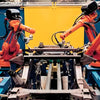How Can TOF 3D Sensors Make Smart Homes Smarter? Tof AIoT Explained

Can TOF 3D Sensing Help Smart Homes Understand You Better?
With the continuous expansion of the smart home market, users are demanding smarter, more adaptive living environments. Traditional home automation systems mainly rely on infrared, ultrasonic, or camera-based sensors to perform environmental perception. However, these conventional methods often lack the precision and stability required for complex indoor spaces. The emergence of TOF (Time-of-Flight) technology brings breakthrough 3D sensing capabilities, enabling smart homes to achieve millimeter-level spatial perception and truly intelligent automation.
What sensor is best for measuring distance?
A variety of sensors can detect and measure distance, including distance sensors, distance detectors, and distance measuring sensors. Among these, LiDAR sensors and laser distance sensors stand out for their precision. These devices emit laser pulses and calculate the time it takes for the reflected signal to return, allowing them to accurately determine object distance — a principle also used in laser measure rulers. Compared with traditional methods, laser distance measuring tools deliver faster, more accurate, and more reliable distance detection across various lighting and environmental conditions, making them widely adopted in robotics, drones, smart devices, and construction automation.
1. Growing Need for Intelligent Spatial Awareness
Smart homes depend heavily on spatial perception to provide adaptive, context-aware control. Accurate environmental sensing determines how effectively systems can understand human activity, adjust environmental parameters, and improve safety and comfort. For instance, lighting systems powered by TOF depth data can detect how many people are in a room and adjust brightness and color temperature accordingly. Meanwhile, security systems can recognize human motion patterns and identify potential intrusions.
Traditional sensors—like infrared or ultrasonic detectors—often fail in environments with variable lighting or reflective surfaces. They also struggle to differentiate between multiple people or overlapping movements. TOF (Time-of-Flight) overcomes these limitations by emitting infrared light pulses and measuring the return time, allowing for real-time 3D mapping of the environment. TOF-based sensors can accurately detect distance, shape, and movement under various lighting conditions, providing the foundational data for advanced automation and interaction.
With TOF integration, smart homes are no longer just reactive; they become contextually intelligent, capable of sensing where you are and what you’re doing—automatically adjusting lighting, temperature, or music to suit your lifestyle.
2. TOF and Real-Time 3D Spatial Modeling
The key advantage of TOF technology lies in its ability to create real-time depth maps and 3D spatial models. Each pixel carries distance information, forming a complete volumetric representation of the environment. This allows devices to not only 'see' but also “understand” the physical world.
Key applications include:
-
Smart Lighting Systems: TOF sensors detect the number and location of occupants in real-time. Lighting automatically follows users’ movement, brightening pathways and dimming unoccupied areas for energy efficiency.
-
Home Safety Monitoring: By generating 3D spatial models, TOF sensors detect unexpected changes—such as a door opening, furniture movement, or unauthorized entry—and trigger alerts.
-
Home Security Systems: TOF cameras distinguish between humans, pets, and objects, reducing false alarms. They function reliably even in total darkness or bright sunlight, enabling 24-hour monitoring.
Compared with traditional 2D cameras, TOF sensors are unaffected by shadows or glare. They ensure consistent spatial perception in all lighting conditions, allowing the smart home to maintain smooth operation day and night.
3. Real-World Applications and System Integration
TOF sensors are now widely implemented across smart home devices, enhancing automation, precision, and user experience.
1. Robotic Vacuums: Modern robotic cleaners use TOF-based 3D mapping to navigate efficiently. They recognize obstacles, walls, and furniture, dynamically adjusting routes and cleaning paths. TOF’s real-time depth perception allows them to avoid moving objects like pets or humans.
2. Smart Security Cameras: Integrated TOF modules enable accurate motion detection and depth-based differentiation. These systems analyze 3D silhouettes rather than relying solely on 2D images, drastically improving detection accuracy and reducing false alarms.
3. Intelligent Appliances: From lighting and air conditioners to smart curtains and air purifiers, TOF sensors empower devices to respond to the user’s exact location and activity. Airflow direction, brightness, and temperature are adjusted automatically, optimizing energy consumption and comfort.
Together, these devices form an interconnected smart ecosystem, where TOF depth data allows cross-device coordination—such as adjusting lighting as a robot vacuum moves through a room or modifying air conditioning as people change positions.
4. Technical Challenges and Engineering Solutions
Implementing TOF technology in home environments requires addressing several key challenges:
Lighting Interference: Direct sunlight or reflective surfaces can distort depth data. Advanced AI algorithms and adaptive exposure control mitigate this by dynamically adjusting illumination intensity and filtering out noise.
Data Volume and Processing: TOF cameras generate large data streams. Edge computing and on-device AI processing compress and analyze data locally, reducing latency and cloud dependency. This ensures real-time responsiveness for gesture recognition, environmental sensing, and safety alerts.
Privacy and Security: As TOF sensors capture spatial and behavioral data, strong privacy protection is critical. Local computation, end-to-end encryption, and access control ensure user data stays secure within the device ecosystem.
Through the combination of optimized hardware, intelligent light control, and AI-driven algorithms, TOF sensors achieve stable and accurate depth perception even in highly dynamic home environments.
5. Future Outlook: TOF + AIoT for Next-Generation Smart Homes
The integration of TOF technology and AIoT (Artificial Intelligence of Things) is redefining the future of smart living. By combining depth sensing with artificial intelligence, smart homes evolve from simple automation to predictive, self-learning ecosystems.
-
Predictive Intelligence: AI analyzes TOF depth data to learn user patterns—automatically adjusting lighting, temperature, or music based on activity and time of day.
-
Gesture and Motion Control: TOF sensors enable accurate gesture recognition and micro-motion detection, allowing users to control home devices with simple hand movements.
-
Device Collaboration: Multi-device TOF networks synchronize across appliances, ensuring smooth, coordinated responses throughout the entire home environment.
With improvements in low-power TOF design, AI edge processing, and self-calibrating sensors, smart homes will achieve 24/7 adaptive awareness with minimal energy consumption. This will usher in a new era where homes are not just automated—but intelligently perceptive.
Conclusion
TOF (Time-of-Flight) technology is transforming the smart home industry by bringing real-time 3D spatial awareness and precise environmental sensing. It empowers devices to detect distance, recognize gestures, and interact intelligently with users. As TOF integrates with AIoT, edge computing, and low-power designs, future homes will offer enhanced comfort, efficiency, and security. The evolution from reactive automation to proactive intelligence has begun—driven by TOF’s ability to help homes truly 'see, think, and respond.'
Vzense DS86 & DS87 ToF 3D Cameras - Industrial Grade, High Precision,5m1600*1200

After-sales Service: Our professional technical support team specializes in TOF camera technology and is always ready to assist you. If you encounter any issues during the usage of your product after purchase or have any questions about TOF technology, feel free to contact us at any time. We are committed to providing high-quality after-sales service to ensure a smooth and worry-free user experience, allowing you to feel confident and satisfied both with your purchase and during product use.







